Top Tools for LED Energy Savings Calculations
Explore essential tools for calculating energy savings and ROI when upgrading to LED lighting in commercial settings.

Switching to LED lighting can save businesses money, but calculating those savings requires the right tools. This article reviews six tools designed to estimate energy savings and ROI for LED retrofits. Whether you're managing a small office or a large industrial facility, these tools help you make informed decisions about upgrading your lighting.
Key Takeaways:
- Luminate Lighting Group: Offers on-site audits for precise, tailored ROI projections, including rebate opportunities.
- ENERGY STAR Light Bulb Calculator: A simple Excel tool for quick savings estimates based on wattage, hours, and electricity rates.
- Meomi Lighting Calculator: Online and Excel options for detailed financial insights, including payback periods.
- LightbulbWholesaler.com Calculator: User-friendly online tool with preset averages for quick calculations.
- TEAM Energy Calculator: Focused on large-scale projects, requiring a minimum of 50 bulbs.
- TCP Lighting ROI Calculator: Designed for commercial settings, factoring in labor costs and operating schedules.
Quick Comparison:
| Tool | Best For | Input Complexity | Key Outputs |
|---|---|---|---|
| Luminate Lighting Group | Large, complex facilities | High | Custom ROI, rebates, payback |
| ENERGY STAR Calculator | Small offices, quick estimates | Low | Annual savings, payback period |
| Meomi Lighting Calculator | Mid-size commercial spaces | Medium | ROI, energy cost savings |
| LightbulbWholesaler.com | Retail, small businesses | Low | Savings, ROI |
| TEAM Energy Calculator | Large-scale industrial projects | Medium | Savings, maintenance costs |
| TCP Lighting ROI Calculator | Facilities with high labor costs | Medium | ROI, payback report |
Each tool has strengths tailored to specific needs. Start with simpler calculators for initial estimates, then use advanced tools or audits for detailed planning.
How to Accurately Calculate LED Lighting Retrofit Savings
1. Luminate Lighting Group Energy Audit and ROI Services
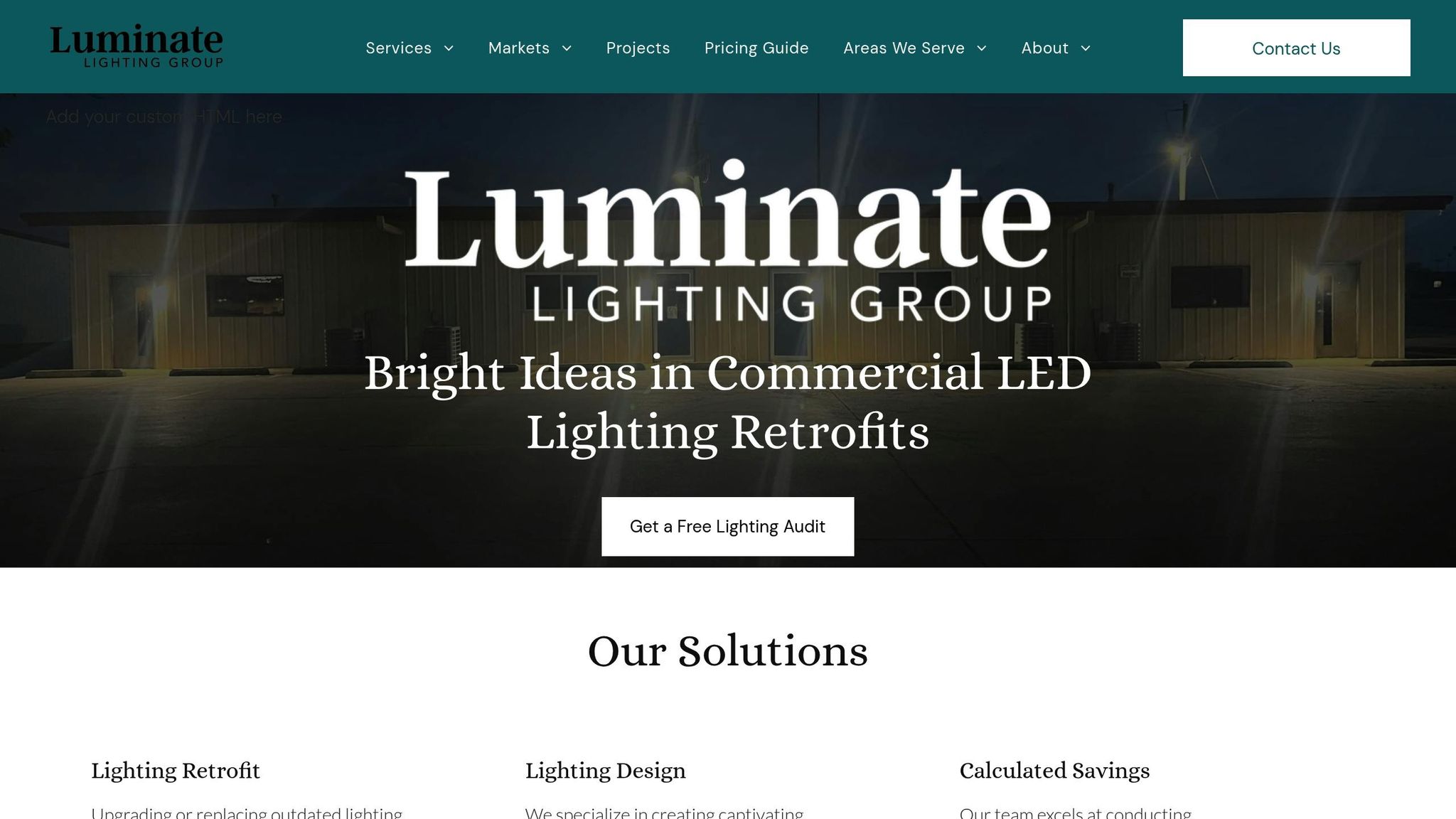
Luminate Lighting Group provides energy audit services designed to deliver tailored insights for commercial LED retrofit projects. Their process includes on-site evaluations to capture the unique features of each facility, resulting in customized ROI projections that reflect real-world conditions.
Input Requirements
The energy audit begins with an on-site visit, where Luminate's team gathers detailed information about the facility. This includes documenting existing lighting fixtures, their quantities, and any control systems in place. This hands-on approach ensures no critical details are missed - something online calculators often fail to achieve.
Their Energy + ROI Analysis incorporates key factors such as current wattage, operating hours, and local electricity rates. By focusing on these variables, they generate precise financial projections that clients can rely on.
Output Metrics
Luminate’s audits produce detailed financial projections, offering insights into current energy usage, estimated savings, payback periods, and overall ROI. Beyond just dollar figures, they identify rebate opportunities and incentive programs that could significantly improve the financial outlook of the project.
"Our team excels at conducting comprehensive energy audits on current lighting fixtures and devising precise estimates of potential energy savings. Through meticulous analysis, we develop detailed models to showcase the projected efficiency improvements, helping clients make informed decisions towards sustainable lighting solutions."
These services are further customized to align with local market conditions, ensuring accurate and actionable recommendations.
Customization Options
Luminate goes beyond basic ROI projections by tailoring their calculations to reflect local utility incentives. Their expertise is focused on U.S. commercial markets, particularly in Texas, Arkansas, and Oklahoma. With in-depth knowledge of local electricity rates and rebate programs, they help clients maximize their savings. For example, they work closely with utility providers like Oncor, which serves regions such as Dallas–Fort Worth, Austin, Houston, and Texoma in Texas.
The team also handles the often-complicated rebate application process, ensuring clients receive the full benefit of available incentives. This regional know-how guarantees that ROI projections are based on actual opportunities rather than generic estimates.
Ease of Use for Commercial Applications
Unlike online tools that require facility managers to input their own data, Luminate’s service is fully turnkey. They offer on-site lighting audits at no upfront cost for qualifying commercial and industrial facilities. During these audits, they document existing fixtures, calculate potential energy savings, and design custom LED retrofit solutions.
This approach is particularly beneficial for complex commercial environments, such as warehouses, industrial facilities, office buildings, parking lots, and sports arenas. These spaces often have diverse lighting needs, and Luminate’s tailored solutions ensure every area is addressed effectively.
2. ENERGY STAR Light Bulb Savings Calculator
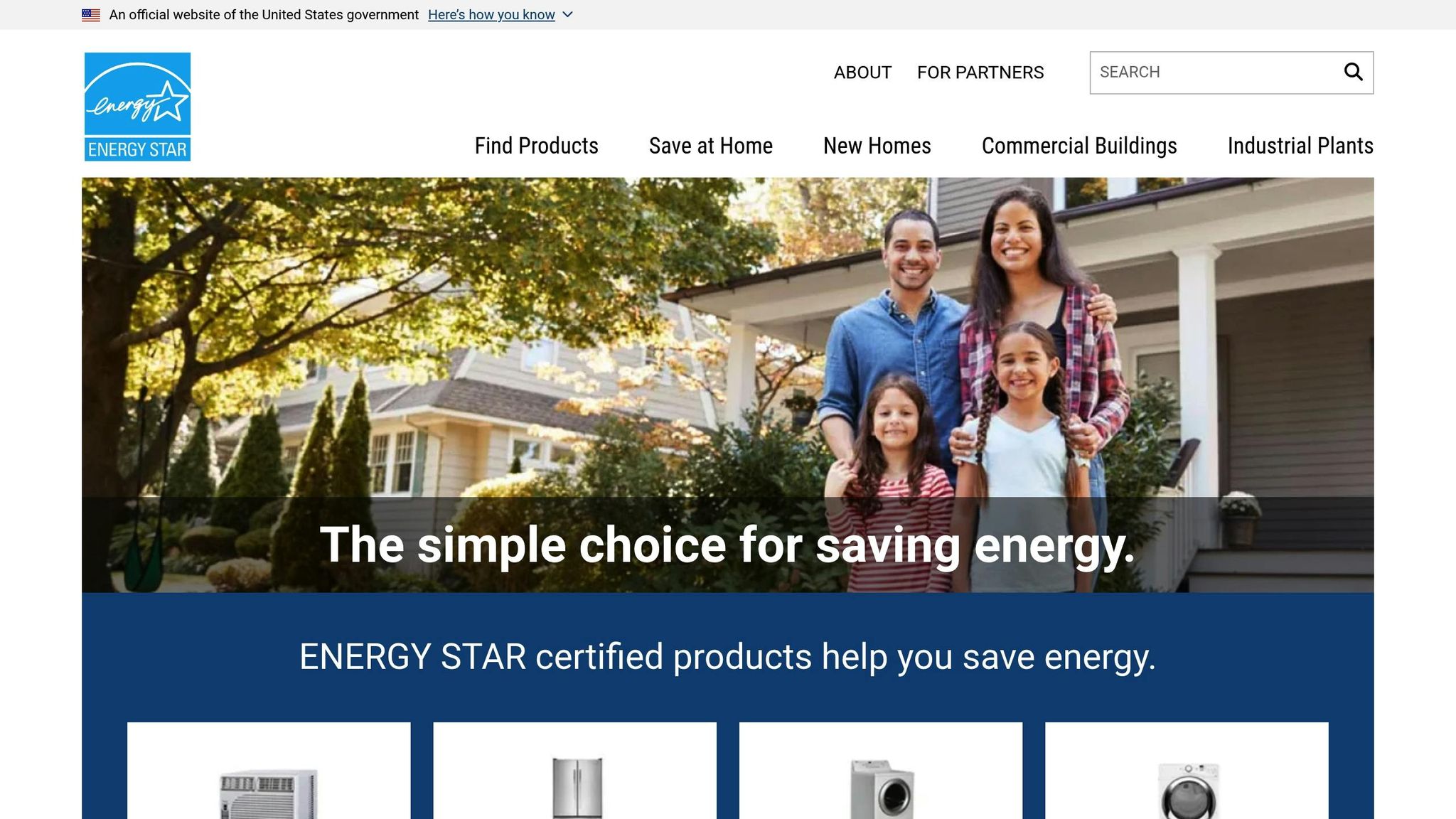
The ENERGY STAR Light Bulb Savings Calculator is a downloadable Excel tool designed to estimate potential savings from switching to LED lighting. Backed by federal energy efficiency standards, this tool offers flexibility for tailored calculations, making it a practical resource for businesses looking to evaluate energy-efficient upgrades.
Input Requirements
To generate accurate savings estimates, the calculator needs three essential pieces of information:
- Wattage: The power of your current fixture, typically listed on the fixture label or calculated using the formula (120 V × Amps).
- Daily Operating Hours: The average number of hours per day the lights are in use. For facilities with varying schedules, you may need to estimate actual usage.
- Electricity Rate: Your cost per kilowatt-hour (kWh), which can be found on your monthly utility bill.
Output Metrics
Once the inputs are entered, the tool provides projections for both energy and cost savings. These insights are especially valuable for businesses, helping them assess the financial benefits of upgrading to LED lighting. The data can also support budget planning and proposal preparation.
Customization Options
The Excel-based format allows users to fine-tune the calculations by adjusting parameters like operating conditions and local electricity rates. It even includes options for state-specific adjustments, ensuring results are as relevant as possible.
Designed for Commercial Use
The spreadsheet is tailored to meet the needs of facility managers and energy coordinators. It supports scenario analysis and can be easily incorporated into facility reports. Plus, ENERGY STAR's government backing adds credibility, making it a reliable tool for presenting LED retrofit proposals to decision-makers or executive teams.
3. Meomi Lighting Energy Savings Calculator
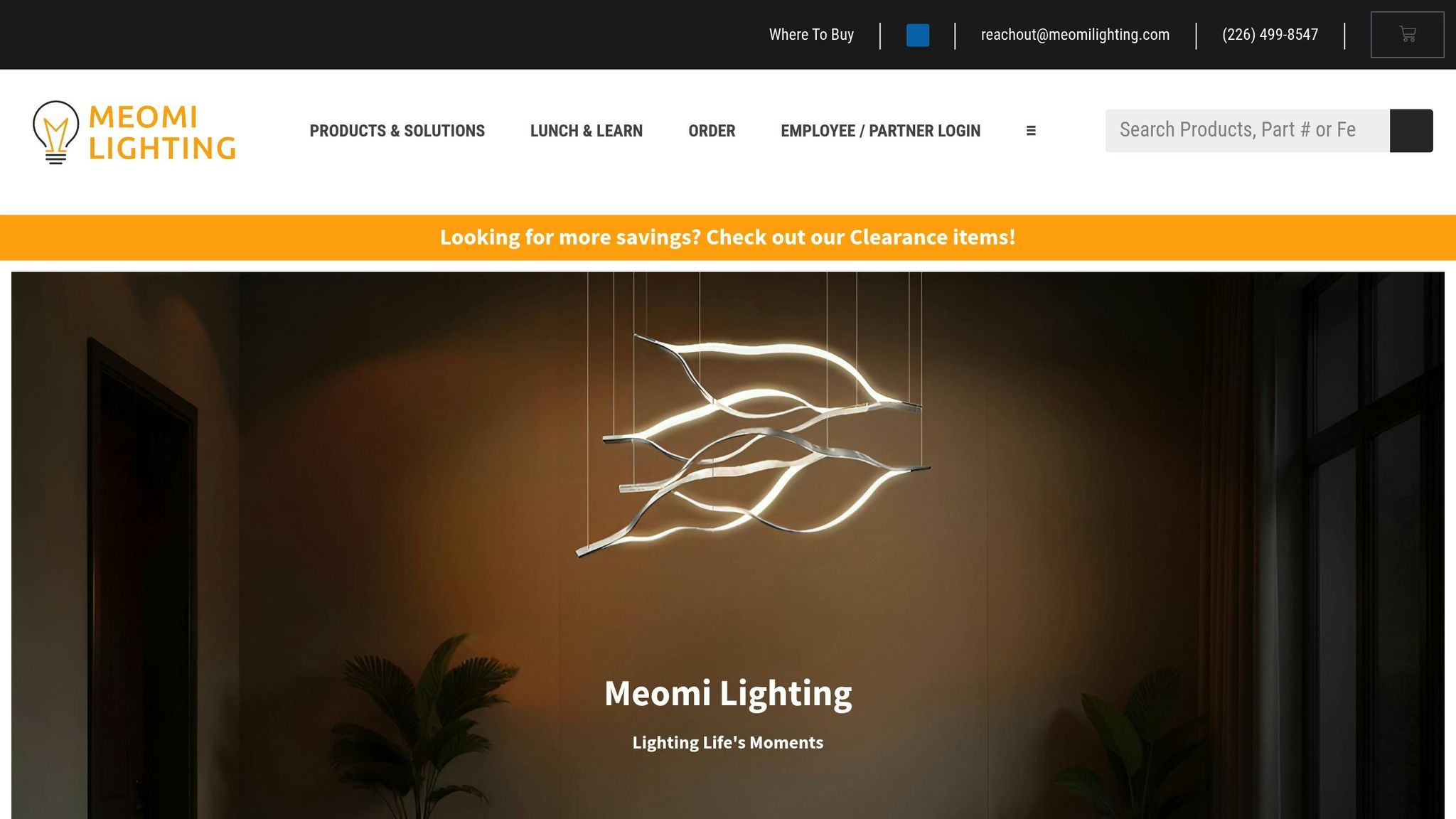
The Meomi Lighting Energy Savings Calculator stands out as a straightforward tool for assessing the financial benefits of switching to LED lighting. Available both as an online tool and an Excel file, it helps users compare their current lighting setup with a proposed LED upgrade. This comparison provides the financial insights needed to make informed decisions about lighting investments. Let’s break down its key features, from input requirements to output metrics.
Input Requirements
To get started, you’ll need to input details about both your existing lighting system and the proposed LED upgrade. Here’s what the calculator asks for:
For your current setup:
- Number of lamps per fixture
- Total number of fixtures
- Power input per fixture (measured in watts)
- Annual operating hours, including peak and off-peak times
For the LED system:
- Power consumption per fixture (in watts)
- Electricity cost per kilowatt-hour (kWh)
- Total upgrade cost per fixture, including installation
- Expected inflation rate for long-term financial projections
Output Metrics
Once you’ve entered the data, the calculator provides key financial benchmarks to guide your decision-making. These include:
- Annual energy cost savings
- Simple payback period
- Return on investment (ROI)
Customization Options
The tool offers flexibility based on your needs. Use the online version for quick estimates, or dive deeper with the Excel file, which allows for more detailed and customizable analysis.
Designed for Commercial Use
This calculator is particularly helpful for facility managers and businesses planning large-scale LED retrofits. By factoring in installation costs and inflation, it delivers a realistic picture of the total project cost and its long-term financial benefits. It’s an effective way to build comprehensive proposals and make confident lighting investment decisions.
4. LightbulbWholesaler.com Energy Savings Calculator
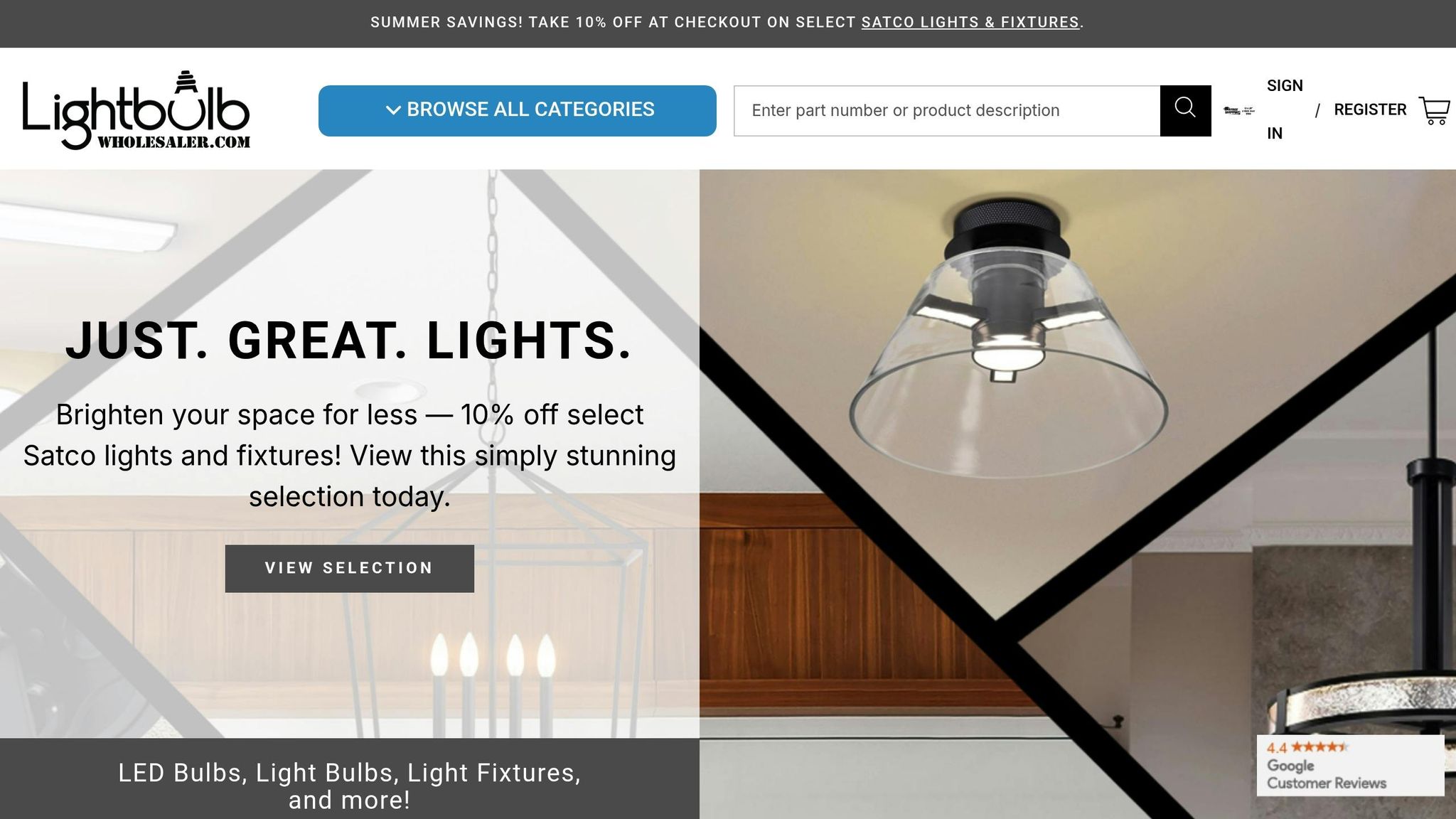
The LightbulbWholesaler.com Energy Savings Calculator is a handy online tool designed to simplify the process of planning LED retrofits. Using preset national averages, it makes calculations quick and easy while also allowing you to fine-tune inputs to match your facility's specific requirements.
What You’ll Need to Input
To get started, you’ll need to provide a few key details about your current setup and plans for LED upgrades. These include:
- The wattage of your current fixtures
- The total number of new LED fixtures you plan to install
- Daily operating hours
- Weekly operating days
- Your local electricity rate (¢/kWh)
You can also adjust the default national averages for a more accurate estimate tailored to your facility’s unique conditions.
What the Calculator Gives You
Once you’ve entered your data, the calculator generates four essential metrics to help you evaluate the financial impact of switching to LEDs:
- Existing Annual Energy Cost
- Proposed Annual Energy Cost
- Annual Savings
- ROI (payback period in months)
These outputs provide a clear picture of potential savings and the time it will take to recoup your investment.
User-Friendly Design for Businesses
This tool is especially useful for facility managers and business owners. Its simple interface eliminates the need for technical expertise, making it accessible to a wide range of users. The inclusion of preset commercial averages ensures reliable estimates, even if you don’t have every detail on hand.
With a 4.4-star rating on Google Customer Reviews, the calculator has earned praise for its ease of use and consistent performance. It’s a practical, no-fuss option for anyone looking to evaluate LED upgrades, complementing other more specialized calculators discussed later in this guide.
5. TEAM Energy LED Lighting Energy Savings Calculator
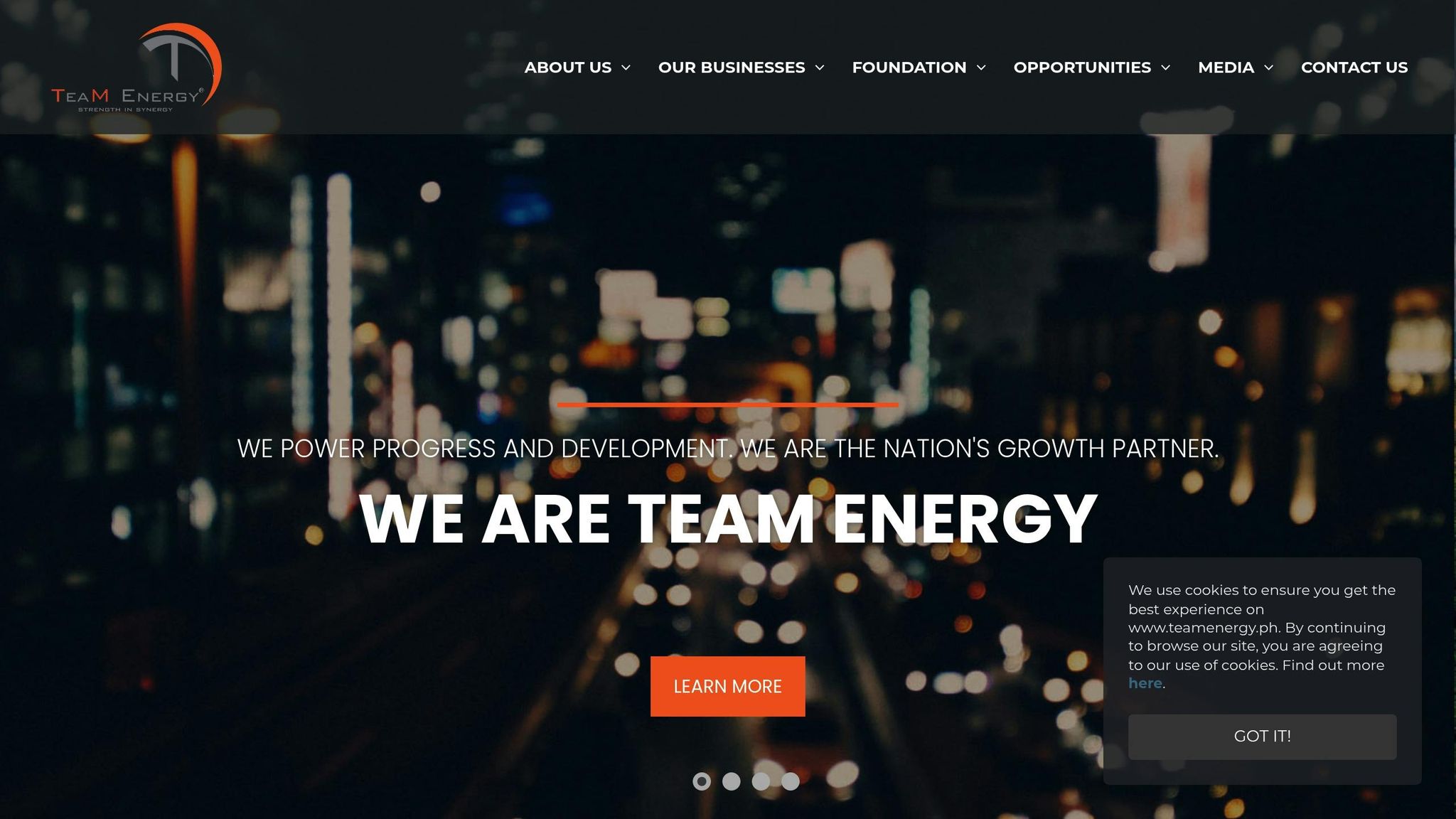
The TEAM Energy Calculator is specifically designed for large-scale LED lighting upgrades, focusing on commercial and industrial projects. It requires a minimum of 50 bulbs, making it less suited for residential use.
What You'll Need to Input
To use the calculator effectively, you'll need to provide the following details:
- The number of bulbs you plan to replace (at least 50 for business purposes)
- The wattage of your current bulbs (e.g., 60W, 75W)
- The wattage of the LED replacements you intend to use (e.g., 10W, 12W)
- The average daily operating hours for the lights
- Your electricity cost per kilowatt-hour, which you can find on your utility bill
These inputs emphasize the calculator's focus on large-scale, energy-efficient lighting solutions for businesses.
6. TCP Lighting ROI Calculator
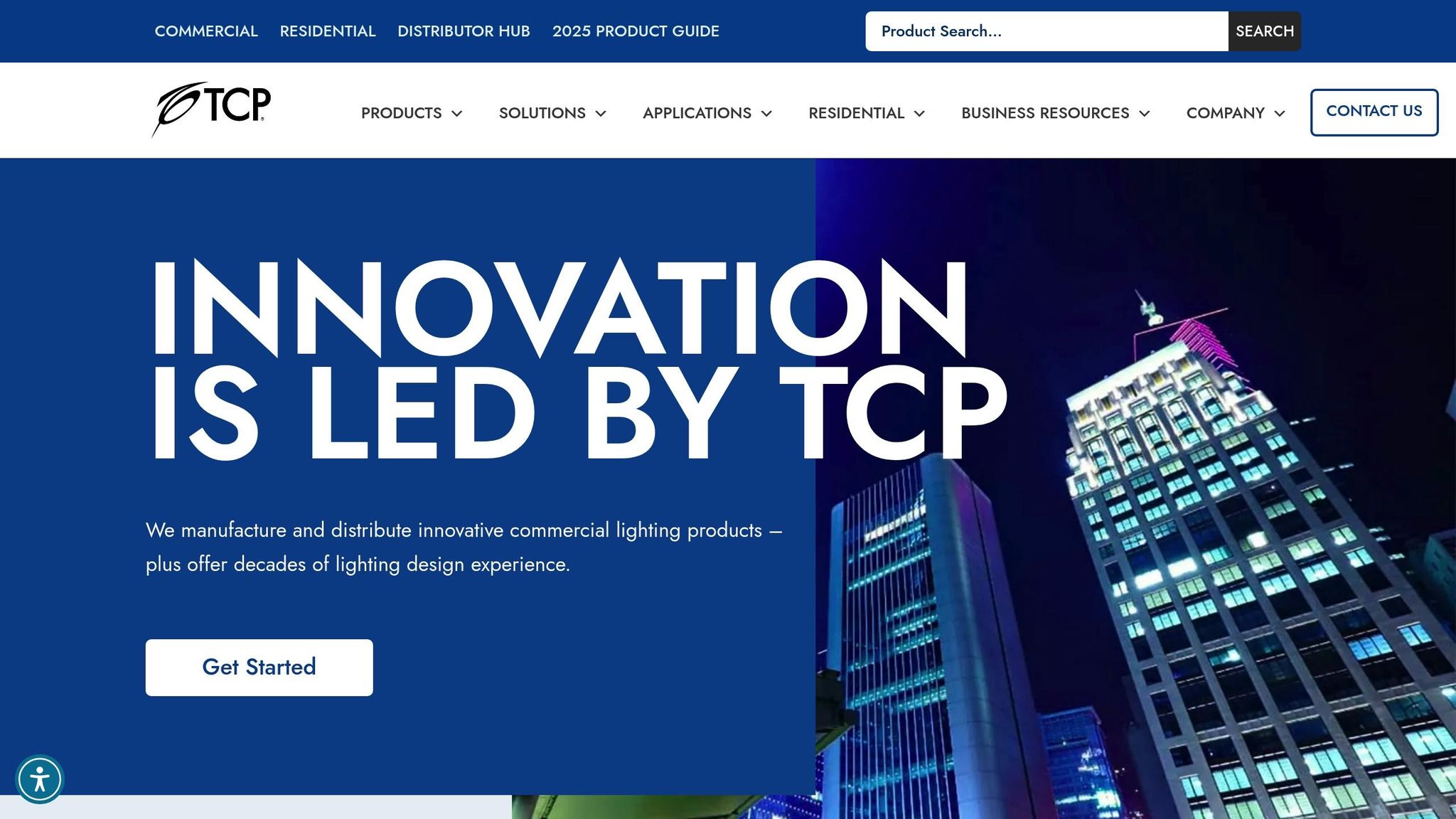
The TCP Lighting ROI Calculator is specifically built for commercial settings, focusing on evaluating the financial aspects of LED retrofit projects. It simplifies the process of estimating the potential savings and benefits of upgrading to LED lighting, making it an essential tool for businesses.
Input Requirements
To deliver precise ROI calculations, the tool asks for key project details such as:
- Current lighting specifications
- Characteristics of the LED replacements
- Operating schedules
- Labor costs
These inputs allow the calculator to estimate energy savings and overall investment accurately.
Output Metrics
The calculator provides a clear breakdown of projected energy savings and return on investment (ROI), helping businesses understand the financial impact of their retrofit projects. It also includes a Payback Report, which calculates how long it will take for the energy savings to cover the initial costs of the upgrade[14, 15, 16].
User-Friendly Design for Commercial Projects
The TCP Lighting ROI Calculator features an intuitive interface, making it easier to handle even complex commercial lighting projects. Businesses can quickly assess potential savings while factoring in unique usage patterns. For the best experience, use the tool with a modern web browser. This calculator, along with earlier tools, completes a robust set of resources for evaluating LED retrofit investments with confidence.
Tool Comparison Chart
Each LED savings calculator offers its own strengths when it comes to U.S. commercial projects. Here's a breakdown of some popular tools to help you decide which one fits your needs:
| Tool | Key Input Requirements | Primary Outputs | Best For | User-Friendliness |
|---|---|---|---|---|
| Luminate Lighting Group Energy Audit | Facility walkthrough, current fixture details, usage patterns, utility rates | Custom ROI analysis, rebate eligibility, 179D tax deductions | Complex commercial projects needing professional assessment | High – Expert guidance throughout the process |
| ENERGY STAR Light Bulb Calculator | Bulb type, wattage, hours of use, electricity rate ($/kWh) | Annual energy savings, lifetime savings, payback period | Quick estimates for simple bulb replacements in small offices | Very High – Minimal inputs required |
| Meomi Lighting Calculator | Current lighting specifications, LED replacement details, operating hours | Energy cost savings and carbon footprint reduction | Mid-size commercial spaces | High – Clean interface with clear results |
| LightbulbWholesaler.com Calculator | Existing fixture details, LED replacement options, usage hours | Cost savings projections and environmental impact | Retail and small commercial applications | High – Step-by-step guidance |
| TEAM Energy LED Calculator | Facility size, lighting types, operating schedules, local utility rates | Comprehensive savings analysis and maintenance cost insights | Large commercial and industrial facilities | Medium – Requires detailed facility knowledge |
| TCP Lighting ROI Calculator | Current and potential lighting information plus labor costs (including operating hours) | Detailed energy savings breakdown, payback report, and ROI analysis | Facilities with extended operating hours and significant labor cost considerations | High – Straightforward data entry |
This chart highlights the best tool for different project needs, based on scale and complexity.
Key Insights for Choosing the Right Calculator
The input requirements for these tools vary widely, from simple details like bulb wattage to more comprehensive data, such as facility walkthroughs and utility rates. Web-based calculators often rely on default assumptions, making them ideal for quick estimates. However, professional audits provide more tailored and precise projections based on your facility's unique operations.
For U.S. businesses, tools that factor in federal tax incentives, such as the 179D deduction, can significantly improve financial projections. For example, the TCP Lighting ROI Calculator is particularly effective for projects where labor costs and extended operating hours play a major role in decision-making.
Another important feature to look for is the ability to input local electricity rates. Tools that allow for these customizations provide more accurate savings estimates and help refine the overall economics of your project.
Strategy for Effective Use
To get the most out of these calculators, consider using them at different stages of your project. Start with a simple web-based tool to gauge feasibility, then move on to more advanced calculators or professional audits for detailed planning and financing decisions. Combining tools in this way ensures you make well-informed choices for your lighting retrofit strategy.
Conclusion
Choosing the right LED energy savings calculator is key to getting accurate ROI estimates for your retrofit project. While web-based calculators provide quick insights, they often rely on generic assumptions, which might not account for your facility's specific operating conditions or local electricity rates. This makes it crucial to use tools that can adapt to your unique circumstances.
For U.S. businesses, it's especially beneficial to use calculators that include federal tax incentives, like the 179D deduction, as they can provide more comprehensive financial projections. Many basic calculators overlook these potential savings, which could significantly impact your bottom line.
If you're looking for a more thorough analysis, professional energy audits - offered by companies like Luminate Lighting Group - provide a deeper dive. These audits include on-site walkthroughs, photometric layouts, and performance assessments, helping you identify rebates and optimize tax benefits.
When deciding on tools, consider the scale of your project. Smaller spaces, like offices, can often rely on simpler calculators such as the ENERGY STAR tool. However, larger facilities benefit from detailed assessments that factor in maintenance needs, light quality, and overall efficiency.
Finally, accurate baseline data and local rate adjustments are non-negotiable. Using your actual utility costs instead of national averages leads to more reliable savings estimates. The right tool or audit method can make all the difference in maximizing the ROI of your LED retrofit.
FAQs
What should I look for in an LED energy savings calculator to meet my business needs?
When choosing an LED energy savings calculator, focus on tools that allow you to input specific details about your business. For example, you should be able to include factors like your current lighting costs, hours of operation, and the potential expense of a retrofit. This ensures the results are customized to reflect your exact situation.
The ideal calculator will break down important metrics such as annual energy savings, payback period, and return on investment (ROI) in a straightforward way. Look for options that are user-friendly and tailored to your type of facility - whether it’s a warehouse, office, or industrial space. Detailed and accurate results can guide you in making smarter decisions about switching to energy-efficient LED lighting.
What should I consider when calculating the ROI for an LED lighting retrofit?
When working out the ROI for an LED retrofit, there are a few key elements you need to keep in mind:
- Upfront costs: This includes the price of materials and installation fees.
- Energy savings: Calculate how much you'll save annually on electricity thanks to the efficiency of LED lighting.
- Maintenance savings: LEDs require less upkeep compared to traditional lighting, which can lower maintenance expenses.
- Incentives and rebates: Don’t overlook utility rebates, energy incentives, or tax deductions like the 179D.
It’s also essential to evaluate your current lighting setup and estimate how long the lights are used each day. These details will give you a clearer picture of your energy savings, payback period, and the long-term financial perks of making the switch.
What financial incentives or rebates are available for businesses upgrading to LED lighting?
Businesses making the switch to LED lighting can tap into a variety of financial incentives and rebates that help offset the initial investment. Many state programs offer rebates that can cover as much as 77% of installation costs, with some even including extra bonuses for energy-efficient upgrades.
On the federal side, businesses might be eligible for tax credits, including deductions of up to $3,200 per project through specific initiatives. Furthermore, utility companies frequently provide rebates to promote energy efficiency, making LED upgrades even more cost-effective.
To get the most out of these savings opportunities, it’s smart to work with experts who can help you navigate the available programs and ensure you qualify for the benefits.





